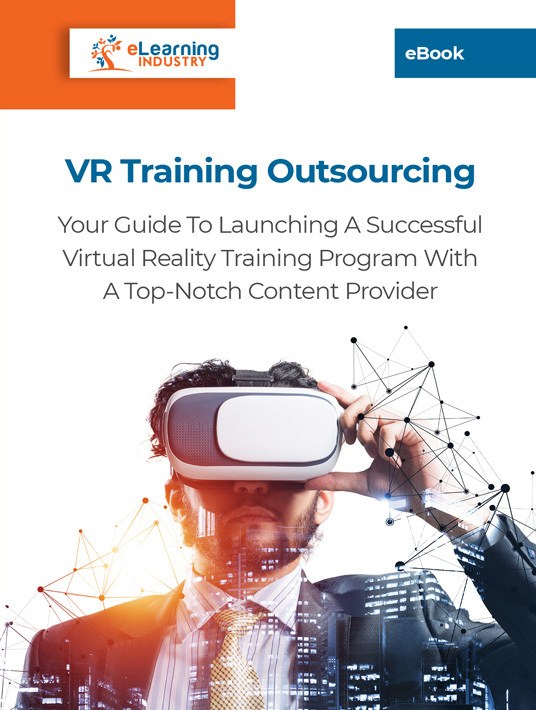Enhance Compliance Training With VR Technology
Mistakes have the power to make or break your business. One wrong move could tarnish your image or put lives in danger. But there is a loophole. VR training facilitates mistake-driven learning so that your employees can learn from errors, instead of letting their skill, knowledge, and performance gaps land your company in hot water. It gives them a safe space to practice tasks and explore different outcomes. Here are 6 cost-effective ways to use Virtual Reality training to reduce compliance risks and turn mistakes into valuable learning opportunities.

1. Develop VR Task Simulations With Built-In eLearning Feedback
VR task simulations let employees go through the motions and practice skills in real-world scenarios. However, the eLearning feedback is often subtler. Employees must sometimes read between the lines to identify performance faults. This is why it’s crucial to sum up the results and offer follow-up recommendations. For example, what steps they missed, which skills they lack, and the support tools they need to improve on-the-job performance. Include links to relevant online training resources and invite them to retake the simulation after they address the issues.
2. Combine 360 Demo Videos With Follow-Up Reflection
Produce 360 demo videos that allow employees to explore their surroundings. Then ask them to point out potential hazards or mistakes. For example, the demo features a customer service employee and an unhappy customer. The staffer shrugs off the customer’s complaint and moves on to the next person in line. Encourage employee training participants to reflect on how they’ve handled similar situations in the workplace. Did they fall into the same trap of treating customers like numbers instead of people? How can they improve their performance to ensure the best CX? What can they do to identify the customer’s needs quickly? Which skills are involved and how can they hone these talents during the next online training session?
3. Evaluate Performance Under Pressure With Branching Scenarios
Pressure is part of the job description for most employees, depending on the job position, department, and experience levels. Thus, every member of the team must be prepared to face obstacles and manage their stress. Develop Virtual Reality training branching scenarios to test how well they handle the pressure and if it clouds their judgment. For example, stress causes them to make every wrong decision instead of stay calm and let their years of experience guide the way. Employees who can take the heat are more likely to advance in their careers and step into leadership roles, while those who crack at the first sign of trouble may need additional performance support and a healthy dose of self-confidence.
4. Use Serious Games To Test Skill Application And Spot Gaps
Serious games are fun, engaging, and entertaining. This makes them the perfect vehicle for skills evaluation. Employees don’t even realize their talents are being tested. They move through the levels and defeat VR enemies—aka clients who want to ignore COI policies. All the while, the LMS tracks their performance and identifies skill gaps. You can even provide eLearning feedback at specific checkpoints and let them repeat the level to mitigate risks. They’re more likely to correct behaviors and learn from mistakes right after they occur. Then explain the consequences of their actions and how they impact their coworkers, clients, and the organization.
5. Turn Real-World Examples Into VR Stories
Reading about compliance issues is boring. Even if you throw in some audio narration and sound effects. The delivery method is passive, so employees are unable to put themselves in the character’s shoes. Virtual Reality training takes them into action. VR stories don’t have to be Oscar-worthy. All you need is a real-world example or case study that resonates with your team. Add images or record brief video reenactments. Then incorporate follow-up prompts or questions to tie everything together. You can even use animation software for potentially dangerous situations, like toxic spill cleanup or emergency preparedness. Keep stories short and sweet so that employees get the information, see how they connect to their job duties and use the knowledge right away. For example, to avoid a safety risk that might land them—or their coworkers—in the hospital.
6. Find A VR Content Provider Who Specializes In Compliance Training
Many organizations avoid VR training because they don’t have the necessary expertise or software. They think it’s too costly to convert all their online training resources into Virtual Reality content. However, you can outsource the task to a VR content provider who specializes in compliance training. In most cases, they already have Virtual Reality activities you can incorporate into your online training program. Or they create custom online training content based on your compliance objectives. In both cases, you need a provider who is familiar with your industry and local regulations. For example, they can adjust pre-existing VR task simulations or video demos to reflect your regional policies. There must also be a way to track employee participation and prove that they meet the minimum requirements, just in case you are audited and need to show LMS documentation.
VR training may not eliminate compliance challenges altogether. However, you can reduce risks by allowing employees to learn from mistakes, so they don’t repeat them in the workplace. Use VR task simulations to point out shortcomings without making them feel singled out. See how they perform under pressure in VR branching scenarios. If you can’t tackle VR training content creation in-house, find a reliable VR content provider with compliance expertise. Outsourcing the corporate eLearning project might be an investment, but consider how much you’ll save in penalties, fines, and insurance claims.
You can launch your own successful VR training program with the right eLearning outsourcing partner, regardless of the resources and size of your business. Download the eBook VR Training Outsourcing: Your Guide To Launching A Successful Virtual Reality Training Program With A Top-Notch Content Provider and find out how to warrant your investment while boosting your employees’ performance and self-confidence.








